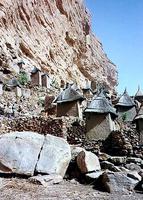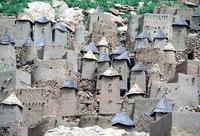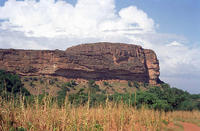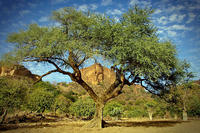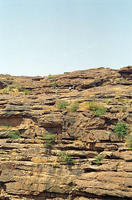You are in: Africa -> Mali -> Cliff of Bandiagara ... , and traditional search or Image Gallery will yield results of this site only
Cliff of Bandiagara (Land of the Dogons)
| Site number: | 516 |
|
| Type of site: | Mixed | |
| Date: | - | |
| Date of Inscription: | 1989 | |
| Location: | Africa, Mali, Bandiagara Circle, Mopti Region | |
Up to 75 images are shown here. Click on each for more details or on Image Gallery for more images.
| Description: | An exceptional landscape of cliffs and sandy plateaux, the Bandiagara site boasts some stunning architecture: houses, granaries, altars, sanctuaries and Togu Na, or communal meeting-places. Numerous longstanding social traditions continue to survive within the region, among them masks, feasts, rituals, and ceremonies involving ancestral worship. The Bandiagara plateau is one of West Africa's most extraordinary sites, with its geological, archaeological and ethnological significance set within its striking landscape. --WHMNet paraphrase from the description at WHC Site, where additional information is available. | |
| The Bandiagara Escarpment is an escarpment in the Dogon country of Mali. The sandstone cliff rises about 500 meters above the lower sandy flats to the south. It has a length of approximately 150 kilometers. The area of the escarpment is inhabited today by the Dogon people. Before the Dogon the escarpment was inhabited by the Tellem and Toloy. Many buildings remain from the Tellem. The Bandiagara Escarpment was listed in the UNESCO World Heritage List in 1989. The Cliffs of Bandiagara are a sandstone chain ranging from south to northeast over 200 km and extending to the Grandamia massif. The end of the massif is marked by the Hombori Tondo, Mali's highest peak at 1,115 meters. Because of its archaeological, ethnological and geological characteristics, the entire site is one of the most imposing in West Africa. The cave-dwelling Tellem, an ethnic group later pushed out by the arrival of the Dogons, used to live in the slopes of the cliff. Dozens of villages are located along the cliff, such as Kani Bonzon. It was near to this village that the Dogons arrived in the 14th century and from there they spread over the plateau, the escarpment and the plains of the Seno-Gondo. Today, local guides can take tourist groups on trips along the Escarpment to visit the Dogon villages. A series of trails run along the cliffs, and hostels in each village provide food and lodging. The host villages receive income from the hostels and the tourist tax. --Wikipedia. Text is available under the Creative Commons Attribution-ShareAlike License. | ||
| Source: | http://whc.unesco.org/en/list/516 | |
| Reference: | 1. UNESCO World Heritage Center, Site Page. | |





